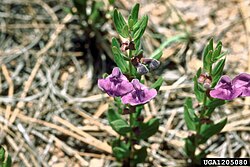| Scutellaria brittonii | |
|---|---|
 | |
| Scientific classification | |
| Kingdom: | Plantae |
| Clade: | Tracheophytes |
| Clade: | Angiosperms |
| Clade: | Eudicots |
| Clade: | Asterids |
| Order: | Lamiales |
| Family: | Lamiaceae |
| Genus: | Scutellaria |
| Species: | S. brittonii |
| Binomial name | |
| Scutellaria brittonii | |
| Synonyms [2] | |
| |
Scutellaria brittonii, also known at Britton's skullcap, is a flowering perennial native to Wyoming, Colorado, New Mexico, Nebraska, and Kansas in the United States. It is classified under the genus Scutellaria and is also part of the mint family, Lamiaceae. [3] [4] It grows on dry mountain slopes and in full sun. [5] [6]

